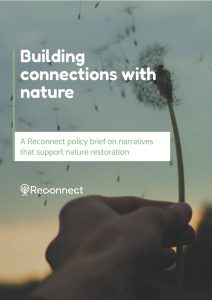Webinar:
The EU Nature Restoration Regulation: Current Status and Next Steps
February 20th, 2025
The EU’s commitment to restoring nature took center stage in the recent IUCN webinar: ‘The EU Nature Restoration Regulation: Current Status and Next Steps’. The event, open only to IUCN members, featured experts from across Europe, including representatives from the European Commission, national ministries, and research projects. The discussion focused on how this regulation could transform the European landscape—not just ecologically, but socially and culturally. A standout contribution came from Marion, one of our RECONNECT partners, who presented her work on narratives, shedding light on how people’s relationships with nature can shape the success of restoration efforts.
Why is the EU Nature Restoration Regulation important?
Nature conservation remains crucial, and in addition to protecting remaining ecosystems, efforts must also focus on restoring ecosystems that have already been degraded. As voluntary targets in the past have fallen short, the new EU Nature Restoration Regulation (NRR) builds on existing legislation and introduces legally binding measures for Member States. The overarching goal is ambitious yet needed: to restore at least 20 % of EU land and sea areas by 2030 and all ecosystems in need of restoration by 2050. To achieve this, Member States will need to prepare detailed national restoration plans (NRPs) by 2027, with draft versions already due in 2026. The importance of timely implementation was echoed by several speakers, who stressed the need for cross-border cooperation, stakeholder engagement, and flexible approaches tailored to local contexts.
Narratives in Nature Restoration: Insights from the RECONNECT Project
Marion’s presentation highlighted a crucial but often overlooked aspect of restoration—how people perceive and relate to nature. In RECONNECT, we explore the diverse narratives that shape people’s connections to the environment, revealing how these stories can support more inclusive and effective restoration efforts. Narratives are more than just stories; they reflect values, experiences, and visions for the future. Through RECONNECT activities in the case study Göttingen, five key narratives emerged from persons living and working around protected areas:
- Learning Landscape: Nature as a space for discovery, education, and connection to ecological knowledge.
- Care Landscape: Emphasizing emotional bonds and the responsibility to protect and nurture ecosystems.
- Collaboration Landscape: Highlighting partnerships between communities, governments, and organizations to achieve common goals.
- Multifunctional Production Landscape: Balancing restoration with sustainable land use, including agriculture, forestry, and tourism.
- Regional Heritage Landscape: Connecting restoration efforts with cultural identity and historical land use practices.
Marion stressed that narratives help people make sense of their connection to nature. They are grounded in lived experiences and surface local knowledge, offering pathways to more meaningful restoration. Importantly, narratives act as connectors—they bridge different perspectives, sectors, and communities, ensuring that restoration efforts are not seen as imposed but as collaborative and beneficial.
Key Recommendations in the context of the NRL are:
- Restoration is more than ecological targets: It must embrace the social and cultural dimensions reflected in narratives.
- Consider multiple narratives: Recognize that people relate to nature differently; successful restoration should reflect these diverse perspectives.
- Embed participatory approaches: Engage communities, amplify local voices, and build restoration strategies that are culturally relevant and locally supported.

Jay, M., Plieninger, T., Martin, R., Cortés Capano, G., Andersson, E., Zürn, Z., Demozzi, T., & Arroyo Schnell, A. (2025). Building connections with nature. A Reconnect policy brief on narratives that support nature restoration.
The RECONNECT Policy Brief offers further insights and is available here: https://zenodo.org/records/14929692
Looking Ahead: Cross-Border Cooperation and Local Action
Other speakers highlighted how the NRL’s success will depend on collaboration across borders and sectors. Serena Arduino (CIPRA International) and Claire de Kermadec (Permanent Secretariat of the Alpine Convention) emphasized the need for transnational approaches, especially in regions like the Alps, where ecosystems transcend political boundaries. Meanwhile, Olli Ojala (Ministry of Environment, Finland) underscored the importance of stakeholder engagement and communication at every stage of the development of the NRPs.
Ultimately, the webinar made clear that nature restoration is not just a technical task—it’s a societal endeavor. As the EU moves forward with this groundbreaking regulation, integrating ecological, social, and cultural dimensions will be key to creating resilient landscapes and thriving communities.
Stay tuned as we continue to follow the progress of the EU Nature Restoration Regulation and the inspiring work of projects like RECONNECT that are shaping its implementation.
Written by O. Aminta Estrada-Leyva